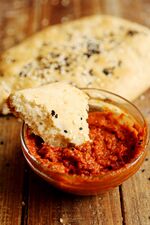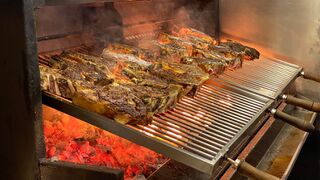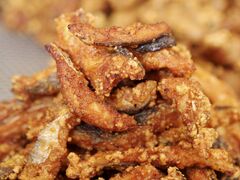Acirian cuisine
Acirian cuisine (Aciriani: Cucina Aciriana) is the cuisine of the Empire of Aciria. It is a Sarpedonian cuisine shaped by the cooking style of the historical tribal regions with heavy influences from Caphirian cuisine following the introduction of Caphirian influence and the eventual of annexation of Aciria into the Third Imperium. Characterised by various meats grilled over hot coals, stews, various cheeses, domestic wines, pasta and bread.
History
Culinary traditions
Ways of eating
Food has been an important part of Acirian communal identity since prehistory, with earliest written records noting both family and tribal meals being commonplace to strengthen bonds. This carries onto modern day with the Brese, a type of dish shared with friends, family or co-workers where the group uses a personal piece of bread to dip into a variety of different sauces. Most popular of these sauces are Pomodolce (a cheese-based white sauce), Pestrone (a tomato based sauce), and Agrodoro (olive oil based sauce).

Other dishes that are enjoyed together with family, friends or co-workers are various stews, like the Marinai Grinese stew, or the Montanaro stew Maccia. The stews are often served as hot as possible to limit the speed its eaten to encourage talking with the company and enjoying the bread served with the stew, like the rye bread Ciaccio served with sweeter sauces, or the white Focaccino served with the more tart or salty sauces. Barbecues are also commonplace in traditional Acirian cuisine, with a particularly long history in Montanaro country, where the communal barbecue of hunted game being a cherished national pastime.
Dining at home
Breakfast in Aciria is often skipped to leave room for lunch. If breakfast is eaten, it usually consists of fresh bread from a local bakery, often a Necciata, with just a light layer of butter on top to be able to be able to enjoy the flavours of the fresh bread better. Sometimes the bread is replaced by, or accompanied by a pastry of some type. The drink of choice usually is a coffee.

Lunch is the main meal of the day, with family often returning home for lunch if possible. Schools in the country offer traditional Acirian lunches, often consisting of various stews or casseroles.
Fresh produce are acquired by families for home-cooked meals from various open-air markets serving the public during the warmest months of the year, often by either the harbor or the market square of the city.
Dining out
Enjoying dinner at restaurants during weekends around 9 or 10 PM is typical for Acirian families. Traditionally sharing a communal dish such as a stew or a Brese, more modern restaurants offer a several course menu with starters that include individual bread and the house sauce, the main source which is typically meat or fish grilled over coals accompanied by various vegetables or potatoes, followed by a dessert that usually is an airy pastry served with coffee. The dinner is usually enjoyed with domestic white- or red wine depending on the region, and while children above the age of 10 are often allowed a small glass of wine per meal, typically children drink water with their meals and enjoy a thick chocolate milk with the dessert.
Regional cuisines
The Acirian cuisine is often divided into Acirian, Marinai and Montanaro cuisines due to the tribal cultures and geographic regions allowed them to develop their own distinct cuisine.
Aciriani
Due to the central location of the Acirianis and the historical Kingdom of Aciria first welcoming Caphirian influence, Aciriani cuisine is seen as the crossroads between Marinai, Montanaro and Caphirian cuisine. It is from the Acirianis where the meats grilled over hot coals and the Brese originate from. It was Aciriani cuisine to widely use pasta in dishes like Pestraccia and Pesceddu, with more individualistic cuisine being developed in the region as opposed the historical communal cuisine that survived better in the Marinai and Montanaro cuisine.
Marinai
The lack of farmland and larger game in the Marinai regions meant a heavier reliance on fishing and hunting of small game such as rabbits and birds. Marinai cuisine is characterized by the unusual amount of soup, a dish that typically frowned upon in Acirian cuisine. Famous Marinai dishes are those like Zuppa di Salmone (Salmon soup) and the Anguilla Fritta (fried eel).
Montanaro
Communal stews and barbecues have a long history in Montanaro cuisine, which it is also characterised by. Montanaro grills are restaurants often established by Montanaros that move out of Montanaro country and the dishes are highly praised by critics.
-
A Montanaro restaurant in Soleramo offering meats over coals.
-
Marinai fried eel is often served with a tomato based sauce.

